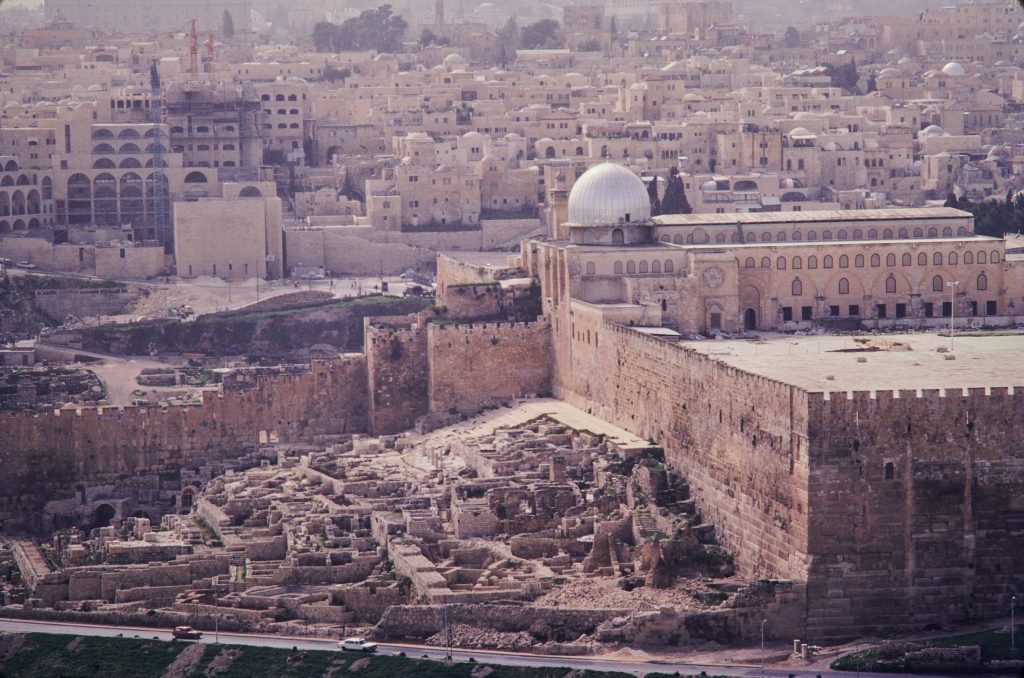Holy Sites

This image is of the original City of David, Jerusalem, a city captured from the Jebuzites. Behind the wall and on the visible platform stood Solomon’s palace and behind it, the Temple. From the point of view of the photo, looking northwest, the palace and temple would have been impressive, gleaming marble in the bright southern sun. If in your mind you take away modern Jerusalem built up around the old city, then from any approach Jerusalem perched on the high ground would be impressive.
In the ancient city of Jerusalem, the temple was the grounding principle around which all of political, economic and social life were determined. The Temple was on Temple Mount, but to note, one had to go through the palace to get to the temple. And as excavations reveal, the palace was much larger than the temple. God was in the temple, but guarded by the king.
The glory of the temple, the only approach being through the even more magnanimous palace may help to understand religion and human history, how this organization of the city of Jerusalem, held once to be the Centre of the Universe, illustrates all the machinations of the human spirit.
In looking at all religions, there is clear partiality shared by all. In the writing of one’s own religion, the proponents of the religion expound on the religion’s highest attributes. Comparatively, in writing about other religions, the proponents of the religion focus on the most base behaviors and failures of the competing religions. Look at how righteous our lofty ideals are compared to the unethical behaviours of everyone else. This is very standard practice! Ion doing so the members can feel justified for claiming the superiority of one’s own religion. In fact, it’s a motivation for member adherence and commitment if they are able to point to the weakness of another religion, and target that religion with a message of one’s own superior revelation and the other’s grievous conduct. New research shows, for example, the key claims of the protestant reformation in attacking Catholicism, such as the widespread corruption with indulgences, were highly overstated. The higher the stakes in religious competition, the more extreme the denunciation of the other. Protestants preached at length about the Pope being the prophesied anti-christ, the supreme enemy of Christ. In turn, Catholicism has justified the killing of infidels, Moslems and, of course, Jews. No religion is pure, escapes these machinations of power and assertion of authority. No matter how pure one believes their religion to be, the same pure sentiments of virtue can be found expressed in other religions. It’s just no one mentions it. Religious campaigns work best if the enemy is proven deserving of condemnation.
If we step back, compare lofty ideals with lofty ideals and behaviours with behaviours, and be willing to accept that our notions of superiority are as tarnished as any other, then we might find humility of spirit, embrace difference as the human condition and live out a life seeking harmony and peace among all religions.
This may be an impossible utopian vision. The story of religion is a human story, cycling through the millennia.
The activity of the great religions is but an extension of the condition of our human nature acted out in history. We have within us most elegant of human aspiration pulling us up and the darkest shadows of violent excess drawing us down. No one wants to think that of oneself, that we are just as readily capable of dark deeds as good ones. We want to feel justified, are depressed and anxious if we don’t, but all of us have within us the seduction of power and the addiction of lust, the potential of betrayal and the possibility of love.
And so is human history, our religions and our history written. We find our way, birth to death, become what we become, at our death, to know the truth, not before. That’s really what religion, any religion in its purity seeks, to reconcile the absoluteness of death with the human will to survive. To hope beyond hope. We follow two ways, to separate the life and death, fabricate great walls of defense, to live within the walls, ignore our death, eventually to have the walls crumble about us, unprepared for the eventual certainty of death. The other way would be to blend life and death into one, to have faith, to follow the road of life where it takes us, to travel hand in hand with love. The defenders on the battlements, apparent winners in life, conquer the world; lovers conquer death.